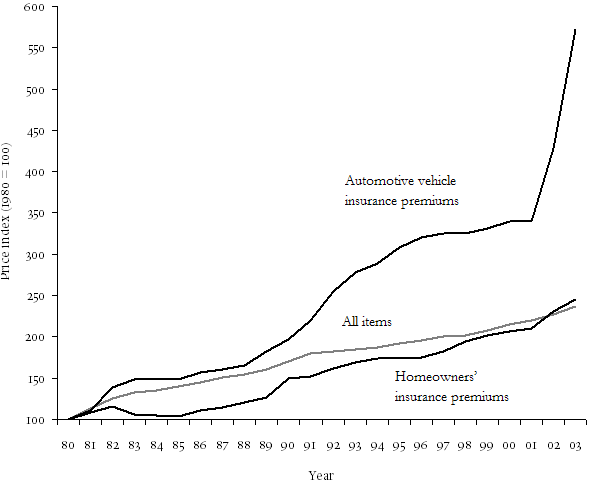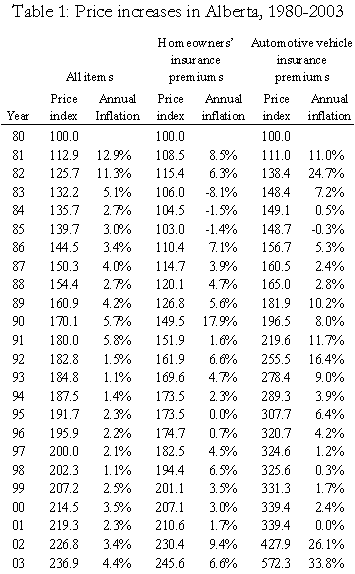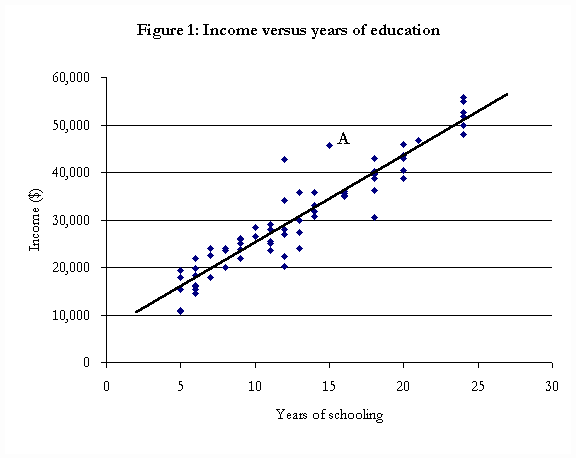by Christopher Bruce
In the first article in this newsletter, I analyzed the arguments concerning eleven possible sources of increased automobile insurance premiums. The purpose of this article will be to review each of those sources to determine whether there are changes in government policy that might reduce premium costs.
1. Number of accidents – Experience Rating.
The Alberta government has already taken one of the boldest and most innovative steps possible towards reducing the number of automobile accidents. This is their proposal to introduce experience rating – the direct tying of premium values to drivers’ accident-causing behaviour – to the automobile insurance sector.
Experience rating has two highly desirable characteristics. First, the individual driver has complete control over his or her premiums. If individuals drive cautiously, avoiding accidents and driving violations, their premiums will decline to the lowest available rate. Furthermore, individual drivers’ rates will not be relatively high just because they happen to belong to a group, like young males, that has a relatively high accident rate.
Second, there is a substantial body of statistical evidence to show that when insurance premiums are related to experience, accident rates fall. When individuals know that they can reduce their premiums significantly by driving more carefully, they do so.
Under the government’s proposal, the impact of a serious driving offence or an at-fault accident will be much greater than it is currently, under what is known as “actuarial” rating of premiums. For example, under the proposed system, a typical Edmonton driver who has recently begun to drive (i.e. who has no “experience”) will pay a premium of about $2,000. After four years of no accidents or driving offences, that driver will pay only $700 – a saving that will continue for each and every year into the future as long as the driver has no accidents or convictions. One would expect an annual saving of $1,300 to be of sufficient size that it would induce most individuals to take additional precautions against unsafe driving.
Furthermore, the proposed system would move the driver four steps up “the premium ladder” each time he or she had an at-fault accident. So the driver with four years of accident free driving would be bumped from the reduced $700 premium to the $2,000 base premium, losing the entire $1,300 “bonus”.
And the incentive to avoid driving convictions is even stronger. A single impaired driving conviction would increase premiums by 200 percent.
These proposals are highly desirable. The government deserves far more credit than it has received for recommending them. Nevertheless, the government needs to reconsider two aspects of its plan.
First, it is mistaken in its proposal that a government agency should set the base premium rate. For example, in the case discussed above, the $2,000 base premium for Edmonton drivers was not one chosen by the insurance companies, but by the government. This is unreasonable for two reasons. First, the government cannot know what the true cost is to the insurance companies of providing insurance. As a result, the base rate that it will choose is almost certain to be either too high or too low.
If it is too high, insurers will make excess profits at the expense of Alberta drivers. If it is too low, insurance companies will make losses and some of them will refuse to provide coverage to Albertans.
Second, when the government sets premiums, the competitive incentive for insurance companies to find ways to lower rates is lost. If insurance companies are forced to charge the same rates regardless of how efficient they are, there is less incentive for them to seek ways of being efficient. It is these competitive pressures that keep premiums from rising more than they have.
There is a simple solution to these problems: the government should set only the percentage increases and decreases that are to result from various “experiences” and leave the insurers to set the base rates from which those increases and decreases are to be calculated. This will get the government out of the business of setting rates, while leaving intact the strong incentives created by a system of experience rating.
The second problem with the new legislation is that it does not deal with the adverse incentives that it gives to insurance companies. Specifically, experience rating results in a situation in which insurers know they will make substantial profits on some classes of customers and lose money on others. Thus, it gives them a strong incentive to refuse to insure the money-losing group. In the scheme proposed by the Renner committee, that group will be composed primarily of young males.
Insurers will lose money on this group because the number of accidents drivers have had in the past is only loosely related to the number that they can be expected to have in the future. What decades of statistics tell us is that a nineteen-year-old male with a perfect, three-year driving record is more likely to have an accident in the next year than is a forty-year-old male with the same driving record. And a nineteen-year-old who had an accident last year is more likely to have an accident next year than is a forty-year-old with the same experience. This means that insurers will expect to pay out more claims to nineteen-year-old drivers than to forty-year-old drivers.
Assume, for example, that ten percent of nineteen-year-old drivers who have had a clean record for three years will have an accident in the next year; whereas only five percent of forty-year-olds with a similar record will have an accident next year. If the average accident costs the insurance company $10,000, it will expect to pay out an average of $1,000 for each nineteen-year-old and $500 for each forty-year-old.
If the government forces insurers to charge the two groups the same premium, they will have to charge something between $500 and $1,000 just to cover their expected claims costs. For example, if the two groups were the same size, the premium would be $750 (the average across the two). But this means that they will expect to make a $250 profit on the average driver in the older group and a $250 loss on the average driver in the younger group.
As insurance companies are profit-driven, we can expect that they will respond by doing their best to attract older drivers – and to turn away younger drivers. The stakes are high. Those companies that find themselves with a relatively high percentage of young drivers will lose money and will soon be forced out of the market. Companies will use every loophole at their disposal to attract as many drivers in the older age groups as possible.
For example, companies might offer to sell automobile insurance through employers, in much the same way they currently sell long-term disability and dental plans. As employees are predominantly in the 25-64 year age group, and as high risk drivers are predominantly in the 16-24 and 65+ age groups, such a practice would allow firms to “skim” off the low-claim drivers.
The government will need to introduce strict controls to ensure that companies are not seriously disadvantaged if they write insurance for groups whose average claims exceed average costs.
2. Severity of accidents – Improved policing.
Reductions in severity are most likely to come from improvements in the design of automobiles; and in the use of safety devices such as seat belts and air bags. Nevertheless, provincial governments can reduce severity by enforcing highway speed limits more strictly – particularly on segments of roads that are known to have high accident rates.
Recent scientific evidence, published in journals such as Accident Analysis and Prevention, Injury Prevention, and the Canadian Medical Association Journal, concludes that the two changes that offer the greatest promise for reducing the incidence and severity of accidents are: first, raising the legal drinking age; and, second, banning the use of hand-held cellular telephones by drivers of moving vehicles.
3. Damages – Restrictions on tort.
Many of the proposals that have circulated in the last year or so have had to do with the placement of restrictions on tort damages. In general, these proposals are based on the assumption that victims are currently being “overcompensated;” hence, a reduction in damages will not cause a hardship to victims. The two most commonly-made proposals are that individuals should not be able to claim from two insurers for the same loss – the “double compensation” issue – and that loss of income should be calculated net of income taxes – because victims do not have to pay taxes on their awards, they will be adequately compensated if damages are based on after-tax income.
Typically, double compensation occurs when the victim is compensated for loss of income both by the defendant and by the victim’s own long-term disability insurance. Under the new legislation in Alberta, victims will be allowed to collect from only one of these parties. This proposal seems reasonable except that it is usually suggested that the victim be required to collect from his or her own insurance company. Effectively this requires that the victim be made to pay for damages caused by a negligent driver – and it allows the negligent driver to evade responsibility for his/her actions. Neither of these outcomes seems defensible. Furthermore, if disability insurers are able to re-write their policies in such a way as to avoid paying damages when their clients are able to collect from negligent drivers, the legislation will affect only disability insurance premiums (which will decrease), not automobile insurance premiums.
The second proposal for reducing tort damages – that victims be compensated only for after-tax losses – also seems reasonable. As plaintiffs do not pay taxes on court-awarded damages, the payment of “gross” income overcompensates them. The primary argument against this proposal is that plaintiffs currently rely on this “overcompensation” to help them pay for their legal fees (which are only partially paid by the defendant). If plaintiffs have to pay for their legal fees out of after-tax income, their awards net of legal fees will leave them undercompensated.
A third element of the new legislation sets limits on the award of “non-pecuniary” damages. This is not based on the assertion that victims are being overcompensated by the courts. Rather, it is based on the assertion that victims of “minor” injuries are exaggerating their injuries and, therefore, defrauding the system. The issue of fraud is discussed in the next section.
4. Fraud.
Setting limits on damages is an entirely inappropriate method of dealing with fraudulent claims, primarily because it punishes the innocent. If fraud is an important factor in the determination of automobile insurance premiums, there are two appropriate responses. Insurers can increase their vigilance; and, in cases of egregious behaviour, they can ask the government to lay criminal charges. As both of these responses are already available to the insurance industry, the government does not need to take further steps.
5. Medical costs.
It is clear that public policy towards medical costs is unlikely to be influenced significantly by government concern over automobile insurance premiums. In this area, drivers and insurers can only hope that government health policy incidentally acts to reduce personal injury claims costs.
6. Legal costs – no fault.
It is often argued that legal costs could be minimized if a form of no fault insurance was introduced. Whatever the advantages of no fault might be, there are three important problems with it that must be dealt with before such a proposal can be considered seriously.
First, because more parties can make claims in a no fault system than in a fault system (“at fault” drivers can make claims in no fault systems but not in fault systems), there is very little chance that no fault will reduce premiums. Indeed, the evidence shows that no fault jurisdictions have premiums very similar to those in fault jurisdictions.
Second, the purported source of savings in a no fault system is that accident victims are denied access to the court system; hence legal bills are reduced. But, the courts serve an important function – they allow parties to appeal decisions made by their insurance companies that they feel are unfair. It is possible that an appeal system can be introduced to no-fault insurance, but there is some evidence to suggest that if such a system really is fair, it will cost as much as do the courts. In short, any savings in administrative costs tend to come at the expense of justice.
Third, there is consistent, strong evidence to suggest that there are more accidents in no fault jurisdictions than in fault jurisdictions because drivers in the former do not have to take responsibility for their actions. (Recent statistical studies conclude that when no fault insurance is introduced, the accident rate rises by approximately 6 percent.) Indeed, not only are the drivers who are at fault for their own injuries not made to pay higher premiums, they are fully compensated by the insurance system for any costs they incur.
7. Return on investment.
If insurance companies have been harmed by falling rates of return on their investments, there is nothing the government can do to help, short of making short-term loans at below-market rates.
8. Administrative costs – Public insurance.
It has often been suggested that administrative costs could be reduced if the private insurance system was replaced by a government-run monopoly. This suggestion ignores the fact that monopolies have been found, almost universally, (i) to be less responsive to their customers than are competitive firms; and (ii) to be less efficient than are firms that have to face competitive pressures. (Some proponents suggest that automobile insurance is less expensive in Saskatchewan and Manitoba than in Alberta because it is provided by monopoly in the former two provinces. However, this ignores the many subsidies that those insurers receive from their governments and also ignores the fact that British Columbia’s premiums are not significantly different from Alberta’s.)
9. Re-insurance.
Following the terrorist attacks of September 11, 2001, re-insurance companies have raised their premiums significantly. As the terrorist attacks should have only a negligible effect on automobile insurance claims, the re-insurers’ actions are unjustifiable. It might be appropriate for the Government of Alberta to provide re-insurance coverage to firms working within Alberta until re-insurance rates return to a level that is consistent with the risk that is being faced.
10. Collusion.
Unless some evidence is presented to suggest that automobile insurers are colluding, no action needs to be taken on this issue.
11. Statistics.
If Statistics Canada has overestimated the rate of increase of automobile insurance premiums and if premiums do follow a regular cycle, which is currently at its peak, then there is little or no rationale for the Alberta government to do anything about premiums. Alberta might cooperate with the Insurance Bureau and Statistics Canada in reassessing the method by which premium inflation is measured; but, otherwise, Alberta merely needs to wait a year or two and that inflation rate will fall significantly by itself. The drastic changes proposed by the government are completely out of line with the (non) seriousness of the situation.
Summary
This article has concluded that the government would be justified in adopting the following policy changes:
- Introduce experience rating, as proposed by the Renner committee, but without government control over the base premium rate.
- Increase police surveillance of moving traffic violations, particularly in areas identified as being of high risk.
- Raise the legal drinking age.
- Ban the use of hand-held cellular telephones by drivers of moving vehicles.
- Introduce a regulation that losses of income be made on an after-tax basis.
- Provide re-insurance to the automobile insurance industry until rates return to a level that can be justified based on expected claims.
- Cooperate with Statistics Canada and the Insurance Bureau of Canada in investigating the manner in which the inflation rate of automobile insurance premiums is measured.

Christopher Bruce is the President of Economica and a Professor of Economics at the University of Calgary. He is also the author of Assessment of Personal Injury Damages (Butterworths, 2004).
![]()


